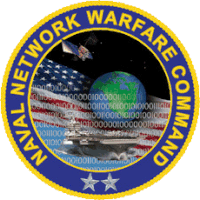
The United States Strategic Command (USSTRATCOM) is one of the eleven unified combatant commands in the United States Department of Defense. Headquartered at Offutt Air Force Base, Nebraska, USSTRATCOM is responsible for strategic nuclear deterrence, global strike, and operating the Defense Department's Global Information Grid. It also provides a host of capabilities to support the other combatant commands, including integrated missile defense; and global command, control, communications, computers, intelligence, surveillance, and reconnaissance (C4ISR). This command exists to give "national leadership a unified resource for greater understanding of specific threats around the world and the means to respond to those threats rapidly".

The Naval Information Warfare Center Pacific, formerly the Space and Naval Warfare Systems Center Pacific, the Naval Command, Control and Ocean Surveillance Center (NCCOSC) RDT&E Division, the Space and Naval Warfare Systems Center San Diego, and the Naval Ocean Systems Center (NOSC), provides the U.S. Navy with research, development, delivery and support of integrated command, control, communications, computers, intelligence, surveillance and reconnaissance (C4ISR), cyber and space systems and capabilities across all warfighting domains. The only Naval technical center headquartered in a major fleet concentration area, NIWC Pacific manages strategic locations both in the Pacific theater and around the world.

The Naval Information Warfare Systems Command (NAVWAR), based in San Diego, California is one of six SYSCOM Echelon II organizations within the United States Navy and is the Navy's technical authority and acquisition command for C4ISR, business information technology and space systems. Echelon II means that the organization reports to someone who, in turn, reports directly to the Chief of Naval Operations on the military side. From a civilian perspective, NAVWAR reports to the Assistant Secretary of the Navy (RDA). The command was formerly known as Space and Naval Warfare Systems Command (SPAWAR) and was renamed in June 2019 to better align its identity with its mission.

Command and control is a "set of organizational and technical attributes and processes ... [that] employs human, physical, and information resources to solve problems and accomplish missions" to achieve the goals of an organization or enterprise, according to a 2015 definition by military scientists Marius Vassiliou, David S. Alberts, and Jonathan R. Agre. The term often refers to a military system.

The Navy Expeditionary Combat Command (NECC) is an echelon III command of the United States Navy, which serves as the single functional command to centrally manage current and future readiness, resources, manning, training and equipping of the United States Navy's 21,000 expeditionary forces who are currently serving in every theater of operation. The NECC was established in January 2006. NECC is a subordinate command of the Navy's Fleet Forces Command.
The structure of the United States Navy consists of four main bodies: the Office of the Secretary of the Navy, the Office of the Chief of Naval Operations, the operating forces, and the Shore Establishment.
The Naval Security Group (NAVSECGRU) was an organization within the United States Navy, tasked with intelligence gathering and denial of intelligence to adversaries. A large part of this is signals intelligence gathering, cryptology and information assurance. The NAVSECGRU organization was active from March 1935 to September 2005.
A cyber force is a military branch of a nation's armed forces that conducts military operations in cyberspace and cyberwarfare. The world's first independent cyber force was the People's Liberation Army Strategic Support Force, which was established in 2015 and also serves as China's space force. As of 2022, the world's only independent cyber forces are the PLA Strategic Support Force, the German Cyber and Information Domain Service, Norwegian Cyber Defence Force, and the Singapore Digital and Intelligence Service.
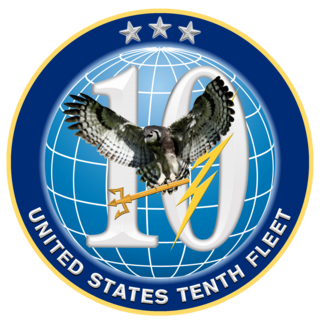
The U.S. Tenth Fleet is a functional formation and a numbered fleet in the United States Navy. It was first created as an anti-submarine warfare coordinating organization during the Battle of the Atlantic in the Second World War. It was reactivated as a force provider for Fleet Cyber Command on 29 January 2010. U.S. Tenth Fleet serves as the numbered fleet for U.S. Fleet Cyber Command and exercises operational control of assigned naval forces to coordinate with other naval, coalition and Joint Task Forces to execute the full spectrum of cyber, electronic warfare, information operations, and signal intelligence capabilities and missions across the cyber, electromagnetic, and space domains.
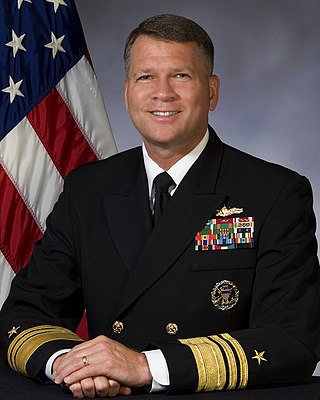
David John "Jack" Dorsett is a corporate vice president for cyber and C4 at Northrop Grumman, and a retired vice admiral of the U.S. Navy. He was the first Deputy Chief of Naval Operations for Information Dominance and 63rd Director of Naval Intelligence. He served as the Director of Intelligence, Joint Chiefs of Staff from 2005 to 2008 prior to assuming his position on the Chief of Naval Operations staff.
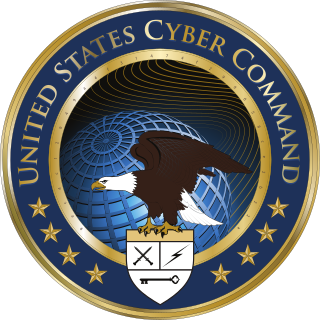
United States Cyber Command (USCYBERCOM) is one of the eleven unified combatant commands of the United States Department of Defense (DoD). It unifies the direction of cyberspace operations, strengthens DoD cyberspace capabilities, and integrates and bolsters DoD's cyber expertise which focus on securing cyberspace.
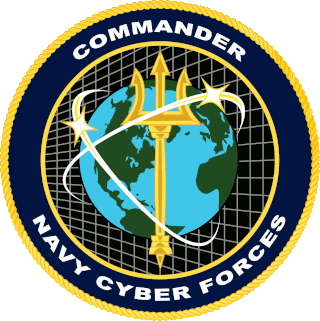
The Navy Cyber Forces (CYBERFOR) was the Type Command (TYCOM) for the U.S. Navy's global cyber workforce. The headquarters was located at 115 Lake View Parkway in Suffolk, Virginia. CYBERFOR provided forces and equipment in cryptology/signals intelligence, cyber, electronic warfare, information operations, intelligence, networks, and space. Navy Cyber Forces was an operational component of the U.S. Navy Information Dominance Corps. CYBERFOR has been absorbed into the Naval Information Forces command.
Cyberwarfare is the use of computer technology to disrupt the activities of a state or organization, especially the deliberate attacking of information systems for strategic or military purposes. As a major developed economy, the United States is highly dependent on the Internet and therefore greatly exposed to cyber attacks. At the same time, the United States has substantial capabilities in both defense and power projection thanks to comparatively advanced technology and a large military budget. Cyber warfare presents a growing threat to physical systems and infrastructures that are linked to the internet. Malicious hacking from domestic or foreign enemies remains a constant threat to the United States. In response to these growing threats, the United States has developed significant cyber capabilities.

The U.S. Marine Corps Forces Cyberspace Command is a functional formation of the United States Marine Corps to protect critical infrastructure from cyberattack. Marine Corps Forces Cyberspace Command is the Marine Corps component to U.S. Cyber Command. It comprises a command element, the Marine Corps Cyber Operations Group, and the Marine Corps Cyber Warfare Group, a total of approximately 800 personnel. MARFORCYBER was established on January 21, 2010 under the command of LtGen George J. Flynn,. As of 7 July 2021, MajGen Ryan P. Heritage is in command.
The U.S. Navy Information Warfare Community (IWC) leads and manages a cadre of officers, enlisted, and civilian professionals who possess extensive skills in information-intensive fields. This corps works in information, intelligence, counterintelligence, human-derived information, networks, space, and oceanographic disciplines to support US Navy, Joint and national war fighting requirements. The IWC is part of a U.S. Navy initiative to merge intelligence with command, control, communications, and computers.

The U.S. Fleet Cyber Command is an operating force of the United States Navy responsible for the Navy's information network operations, offensive and defensive cyber operations, space operations and signals intelligence. It was created in January 2010 "to deter and defeat aggression and to ensure freedom of action to achieve military objectives in and through cyberspace". U.S. Tenth Fleet was simultaneously reactivated as its force provider. Since it was founded, the command has grown into an operational force composed of more than 16,000 active and reserve sailors and civilians organized into 27 active commands, 40 Cyber Mission Force units, and 27 reserve commands around the world.

Michael S. Rogers is a retired four-star admiral of the United States Navy. Rogers served as the second commander of the United States Cyber Command (USCYBERCOM) from April 2014 to May 2018 while concurrently serving as the 17th director of the National Security Agency (NSA) and as chief of the Central Security Service (CSS). During his tenure, he helped transform and elevate U.S. Cyber Command into a unified combatant command. Rogers relinquished command to General Paul M. Nakasone on May 4, 2018 and retired from the Navy a few weeks later on June 1, 2018.

The Naval Information Forces (NAVIFOR) is an Echelon III command under US Fleet Forces Command, (USFLTFORCOM). It is the Type Command (TYCOM) for meteorology and oceanography, cryptology/SIGINT, cyber, electronic warfare, information operations, intelligence, networks, and space disciplines. Like other TYCOMs, this is the manpower, training, modernization, and maintenance component for these disciplines. NAVIFOR's mission is to support operational commanders ashore and afloat by providing combat-ready information warfare forces, which are forward deployable, fully trained, properly crewed, capably equipped, always ready, well maintained and combat sustainable. The current commander of NAVIFOR is Vice Admiral Kelly Aeschbach.

Jan Elizabeth Tighe is a retired United States Navy vice admiral who served as Deputy Chief of Naval Operations for Information Warfare and 66th Director of Naval Intelligence from July 15, 2016 to July 2018. Prior to that, Tighe served as the Commander of the Tenth Fleet and Fleet Cyber Command. She became an independent director of Goldman Sachs in December 2018.

Naval Computer and Telecommunications Station Guam is a United States Navy communications facility on the U.S. territory of Guam. It is located on the Naval Base Guam North Finegayan Telecommunications Site along Guam Highway 3 in Dededo, on the northwest coast of the island.
